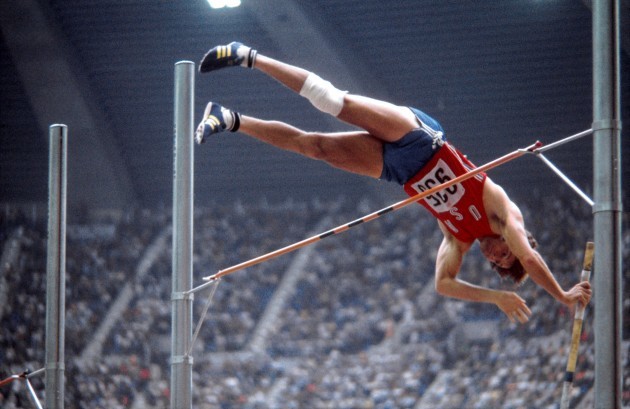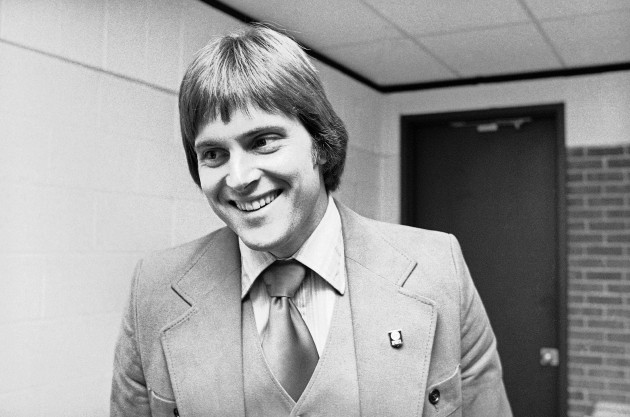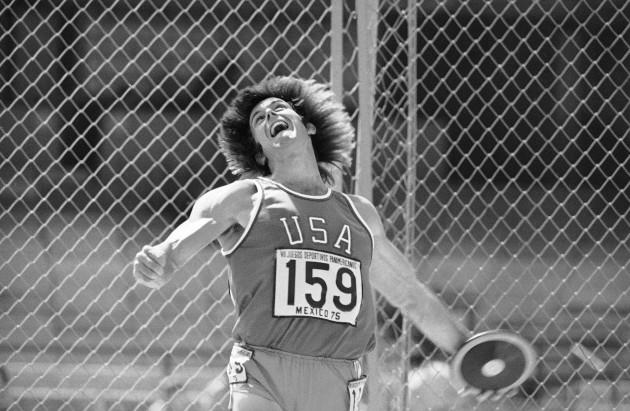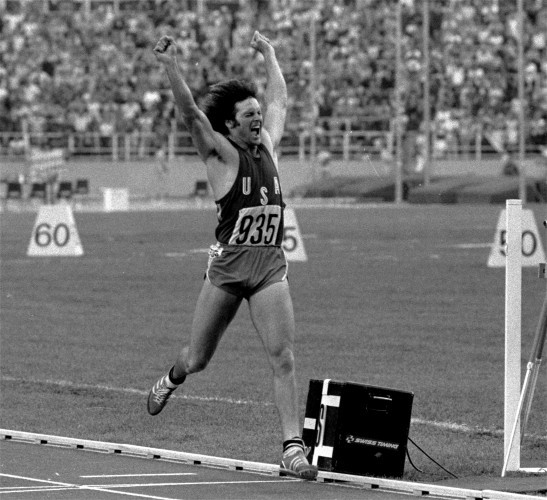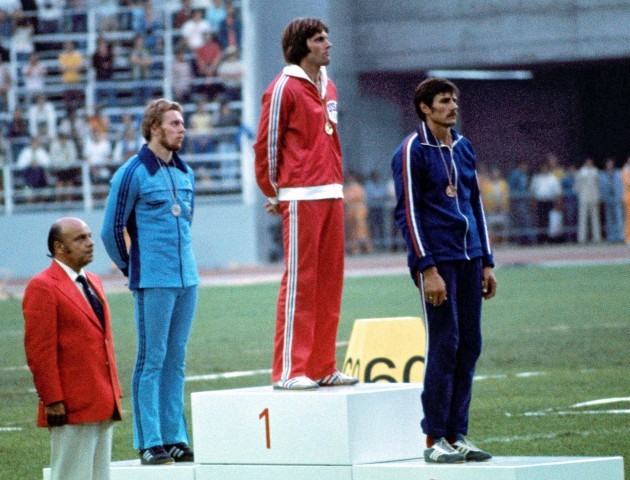TYPING THE WORDS ‘Bruce Jenner’ into Google, the following searches automatically populate: ‘Bruce Jenner interview’, ‘Bruce Jenner Diane Sawyer interview’, Bruce Jenner dress’ and ‘Bruce Jenner woman’.
It’s an indictment of the fascination with the 65 year-old’s decision to transition from male to female that everyone is scrambling to gorge on the latest juicy details. It’s tabloid, it’s celebrity theatre but many don’t know much better.
For the majority, Bruce Jenner is/was the patriarch of the Kardashian/Jenner clan – the perma-tanned, perma-bleached, perma-weird, perma-popular family that the United States has taken to its hearts in this oh-so-devastatingly odd but effortlessly influential era of the reality TV show.
But Jenner’s love affair with the American public began a lifetime ago when he wasn’t some entertainment channel’s walk-on punchline. A lifetime ago, in front of millions worldwide, Jenner became a hero.
The decathlon is a big, high brick wall that nobody is ever going to be able to climb. It’s cold and heartless. It has no mercy. It’s awesome and scary. It will knock you down so fast. Nobody ever beats the decathlon.”Bruce Jenner
In the summer of 1972, a 22 year-old from Westchester County in suburban New York, William Bruce Jenner, went to the Olympics in Munich and competed in the decathlon – that grueling and relentless combined track and field event – for the US. He finished 10th.
A student from Iowa’s Graceland University, a college that had awarded him a football scholarship, he suffered a knee injury in his freshman year that curtailed his involvement on the field.
A phenomenal athlete, his coaches pushed him in the direction of the decathlon and in 1971, just one year after taking it up, he won the NAIA (National Association of Intercollegiate Athletics) championship. Twelve months later, he was an Olympian. But his rapid-rise and effortless, organic talent for the discipline wasn’t much of a surprise.
As a child, Jenner struggled with dyslexia.
I started out with a very poor image of myself. My biggest fear of my life, barring none, was to read in front of the class. I was afraid to go to school. There was always the fear that everyone would find out I was a dummy. I was just stuck with my own problem, and didn’t get much outside help.”
“In the fifth grade, however, I remember running around some chairs in our gym class and I had the fastest time in the whole school. That was pretty good and I could really hold my head up high.”
That gym class proved an epiphany. Jenner was a born athlete. In high-school, he competed in the pole-vault and became a champion. He liked the high-jump too and became a champion at that.
He really liked to water-ski. So, he became a national champion. He was so good, he was offered a job with a show in Florida. He turned it down and went to college instead.
Jenner had a natural flair for sports and the varied content of a decathlon appealed to him. But it was long, tough, brutal. That seemed to appeal to him too. There was a journey, a complicated route to navigate.
There was time to right a wrong – it just required digging deeper and pushing himself further, to the brink of collapse if necessary.
Nothing proved his boundless grit and determination more than the Olympic trials in 1972.
“During the 1500 metres”, Jenner told American Men of Olympic Track and Field, “the last event, I had to have a good race.”
I needed to win by 18 seconds over one of the competitors. I ran eight seconds faster than I had ever done before and won by 21 seconds.”
After his incredible showing in Munich (he had been competing in decathlons for two years and still managed a top-ten finish), he instantly turned his attentions to Montreal four years later.
He and his first wife, Chrystie, relocated to San Jose. Living next door to the running track, Jenner had a daily motivation – exactly what he wanted. No excuses. In the living room of the couple’s two-bedroom apartment, to provide an extra shot of inspiration, he placed a high hurdle.
A few years ago, David Winner conducted a fascinating interview with Wayne Rooney in which they spoke of visualizations. Tiger Woods and Michael Johnson both pictured themselves winning in advance of tournaments or race meets. Rooney dreamed of goals.
“Part of my preparation is I go and ask the kit man what color we’re wearing — if it’s red top, white shorts, white socks or black socks,” he said.
“Then I lie in bed the night before the game and visualize myself scoring goals or doing well. You’re trying to put yourself in that moment and trying to prepare yourself, to have a ‘memory’ before the game. I don’t know if you’d call it visualizing or dreaming, but I’ve always done it, my whole life.”
Decades before, Jenner was doing it. Talk of ‘losing’, ‘hope’, even ‘the possibility of defeat’ was banned from the household. Instead, everything was about ‘winning’, belief in it happening and keeping faith.
For between six and eight hours a day, Jenner trained. Having to work on ten different disciplines, it was a relentless grind. It was punishment. He pounded the track, jumped high, threw long and quickly became the world’s best.
Looking back at footage of Montreal 1976′s opening ceremony, Jenner fits the mold of any superhero. Strolling alongside his US team-mates, his bulging arms are close to ripping through his blazer. With his angular haircut and Hollywood smile, he could easily have passed for an actor playing a role.
It was a fitting contrast. His last Olympics had ended with him desperately and hopelessly bustling towards the finish line. Now, four years later, he confidently swept into The Big O, his mind focused intently on that gold medal.
“I’d done my homework and was physically and mentally ready”, Jenner said later.
I had the world’s record, and had lost only one meet during the last three years of my career. Every breath was crucial but I was so ready for the competition that I was able to come through, performance after performance. In the first event, the 100 metres, I ran the fastest electronic time I had ever run.”
In the 100 metres and the long-jump, Jenner recorded personal bests. In the shot-put, he threw farther than he’d ever done before. In the high-jump, he clears 6’8″ – his fourth successive record of the Olympics. In the heats of the 400 metres, he racks up another PB.
“Getting ready for the final event, the 1500 metres, I knew I had won the meet already – I could feel it. All I had to do was run the 1500 in whatever time – I was going to win. I thought to myself then – the rest of my life is going to be easy, because I learned so much right there.”
Put in the context of recent developments, these words, from 2005, are haunting.
Jenner, in conversation with ABC’s Diane Sawyer, has revealed that in spite of his athletic achievements, he continued to be tortured by confusion in his personal life.
(I was) Running away from my life. Running away from who I was. Scared to death.”
The news of his transition from man to woman and how long he has kept that part of his life hidden from so many for so long ensures his track and field exploits are ripe for analysis for any pseudo-psychologist.
Was there a special attraction to such an unforgivable, unrelenting and punishing discipline like the decathlon? Did Jenner look upon it as some kind of remedy for what he was going through in his personal life? A long-term intense focus to distract from his thoughts and desires and constant stream of self-scrutiny?
That remains speculation and only Jenner can ever know for sure. What is clear is that his career as an athlete was built on determination, spirit and an unwavering faith in himself.
It was those characteristics that drew the admiration, support and love from millions worldwide and it will be those same characteristics that will go some way to easing the troubles ahead.
It was the power of sport which taught Jenner that every seemingly insurmountable challenge can be overcome, every impenetrable wall can eventually be broken down.
Looking back at his 1976 success some years later, he was honest in his assessment of what it takes to be an athlete.
And a person, as it happens.
When you’re out there on the track, it’s a very lonely thing. Even if there’s thousands of people in the stands, television cameras everywhere, 20/30 other competitors down the track, you’re very lonely. Because you personally have to come up with the best performance you can get – nobody else is going to be out there helping you. There’s not going to be another guy who’s going to run the second half of the 400 metres for you. You have to do it all yourself. But on the other hand, you won’t be out there unless there’s other people off the track who have helped you. You don’t want to let them down.”

